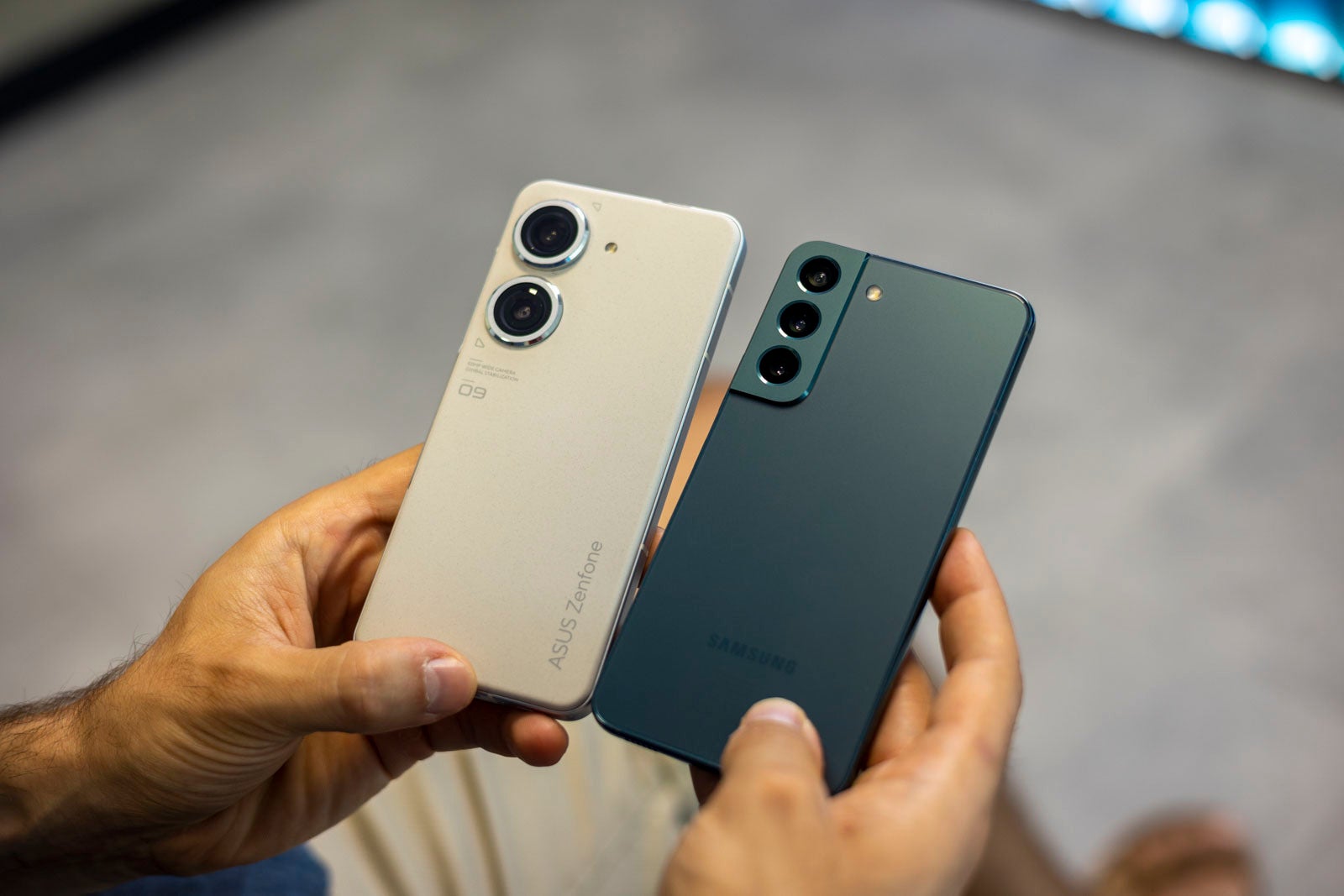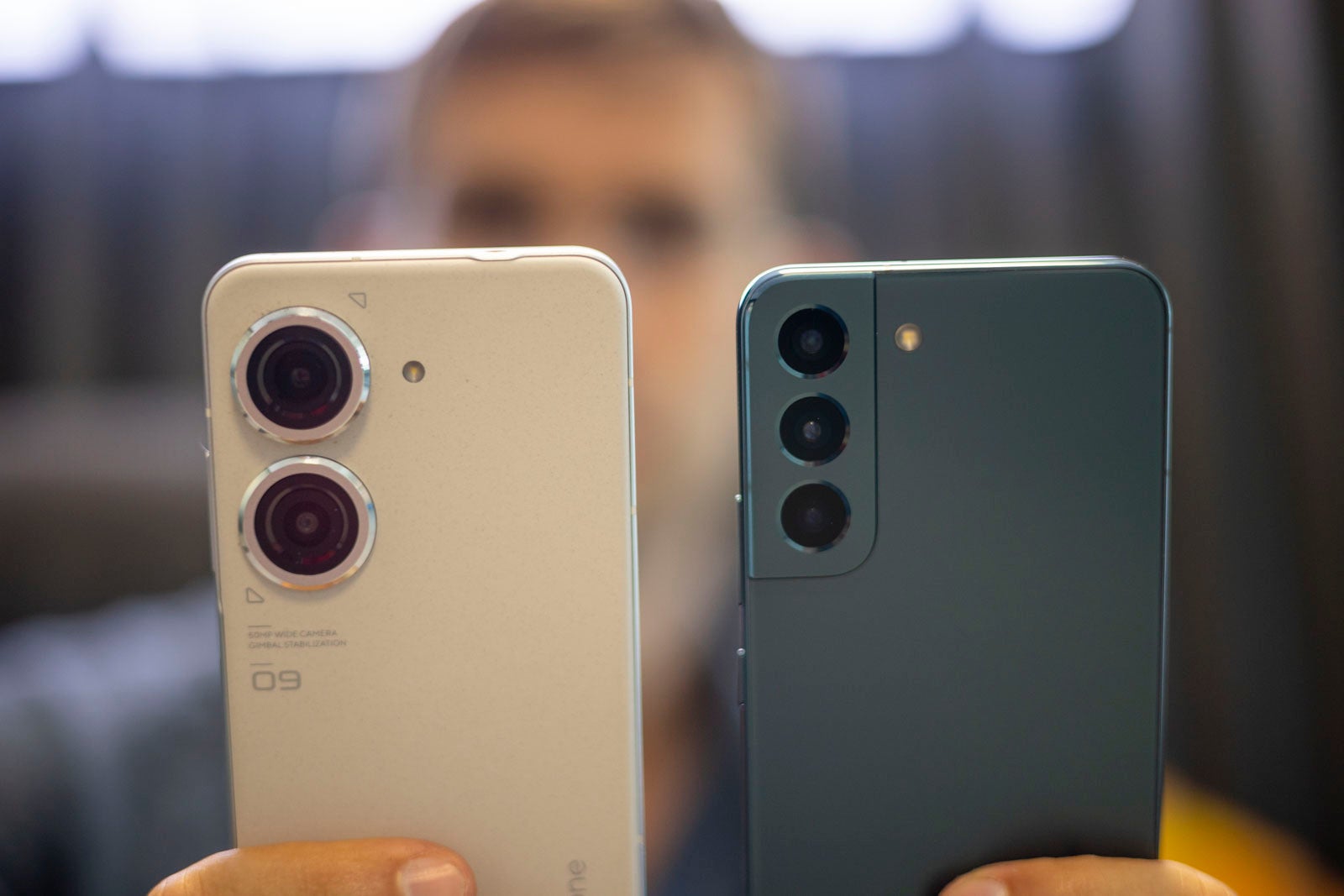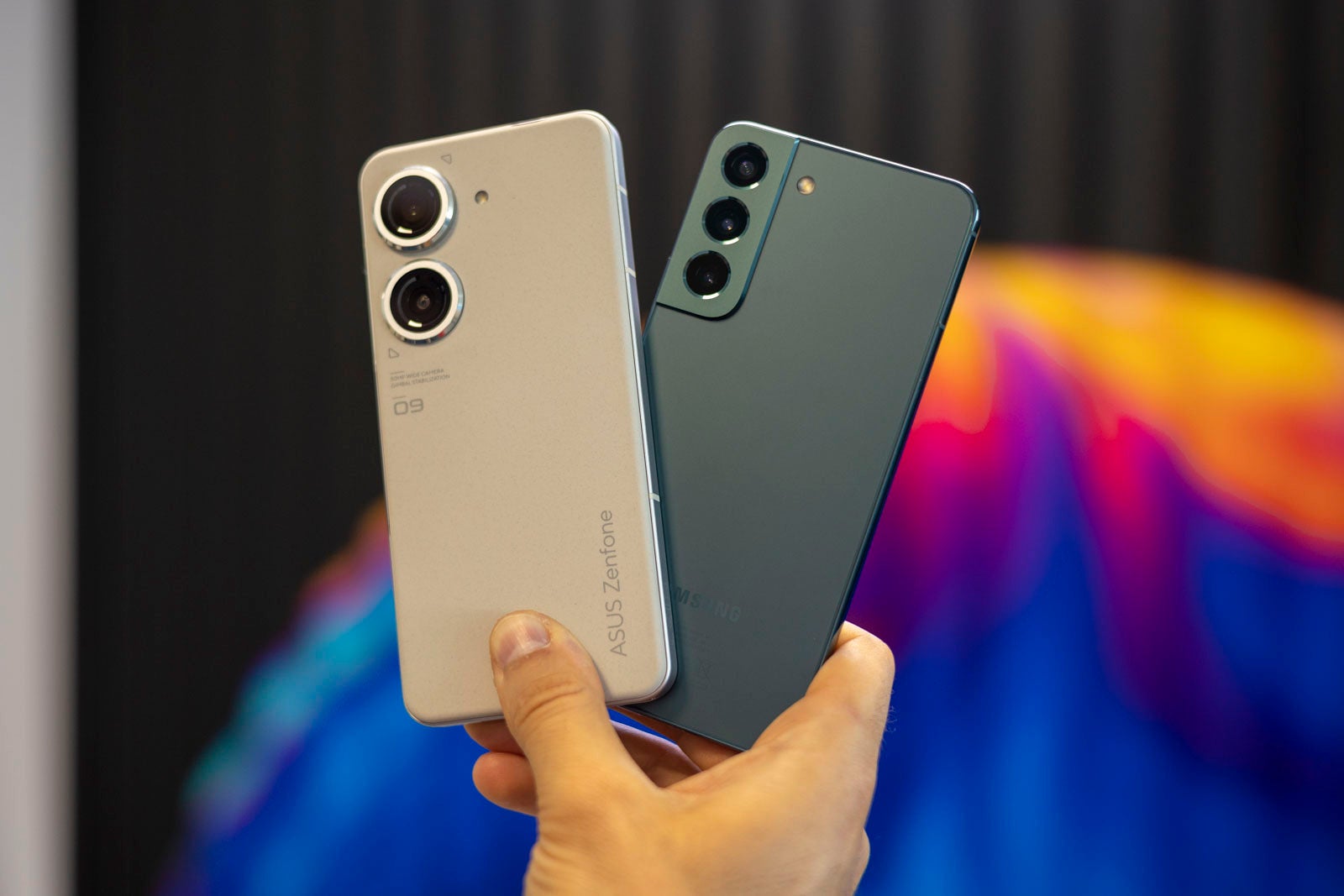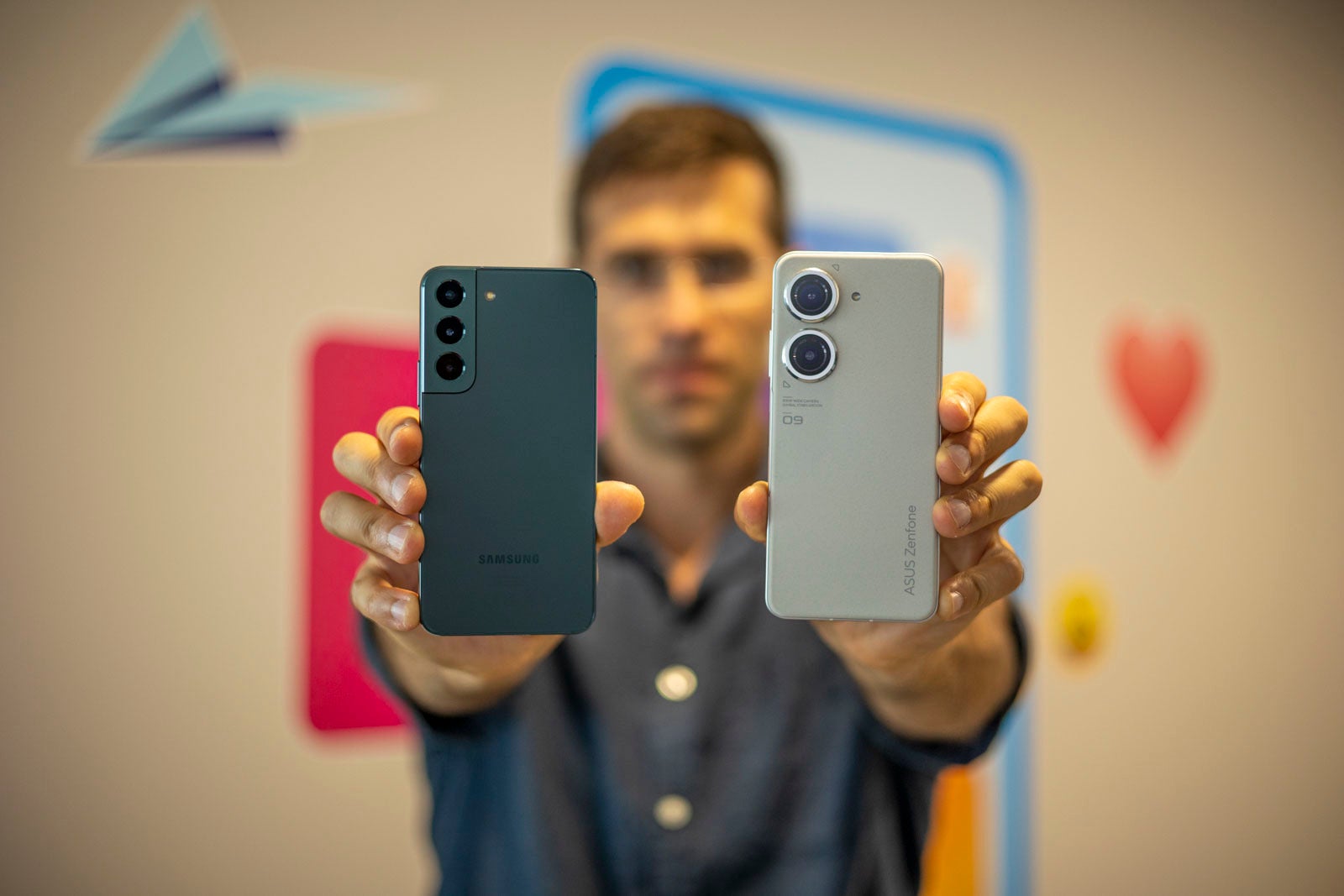Asus Zenfone 9 vs Samsung Galaxy S22: which one is the best “mini” Android?
Intro
The new Asus Zenfone 9 might be the sleeper hit to check out for those looking for a great compact phone.
It improves upon the dull design of its predecessor with something a lot more memorable, but most importantly it ticks all the important boxes with the latest and most powerful chip around, the Snapdragon 8+ Gen1, a bigger battery than you’d expect for the size and even fast charging. All of this warrants a comparison with the most popular compact Android phone in 2022: the Samsung Galaxy S22. Coincidentally, these two are priced about the same, so this makes it all the more interesting.
- Zenfone is a bit more compact, but thicker
- Galaxy has a slightly larger screen
- Zenfone has the newer Snapdragon 8+ Gen1 chip
- Galaxy has a third, zoom camera
- Zenfone has better battery life
- Neither one supports microSD cards
Table of Contents:
Design and Display Quality
The Zenfone is more compact, but we do like the larger screen on the Galaxy as well
With those gigantic camera bumps on the back the Zenfone 9 is easy to recognize in a crowd, even if most people were not quite enamored with the look. The Galaxy also has its own design thing and its own character, but it looks more understated and not so much “in your face”.
Pick them up in your hand, and the Zenfone feels more dense, while the Galaxy is a tiny bit larger but feels lighter, airier.
There is a difference in the size and dimensions too: the Zenfone is noticeably narrower, with a taller screen, but it’s also a thicker device, while the Galaxy is a bit wider but thinner. One little pet peeve we have with the Asus phone is that it wobbles when you lay it flat on its back, even with the provided case, which is quite annoying if you are trying to type while the phone is on a table. The Galaxy once it’s in a case remains perfectly still, which we appreciate.
You then have the latest Gorilla Glass Victus cover glass that ensures scratches won’t appear as easily as on cheaper phones. Both are also IP68 water and dust protected. On the top of the Zenfone you will also find a 3.5mm headphone jack, a useful feature that you don’t get on the Galaxy or most other flagships these days.
Display Measurements:
The Zenfone is equipped with a 5.9-inch screen with a tall and narrow 20:9 aspect ratio, while the Galaxy comes with a 6.1-inch screen with wider proportions. In reality, this means that the actual screen area on the Galaxy is bigger than the numbers suggest. The screen on the Zenfone is tiny and it might actually be a bit too tiny for some folks. Both have 1080p resolution, so they look about equally sharp.
Another difference between the two is in the biometrics: the Zenfone uses a traditional fingerprint scanner that is built in the power key, while the Galaxy uses an ultrasonic fingerprint scanner embedded under the screen. The one on the Zenfone is a bit faster, but it was hard for us to get used to it. The depressed power key is not as easy to find by tactile feel as a traditional button and it is actually harder to just turn on the lockscreen as most of the time you would automatically unlock the phone and skip straight to the home screen. That might be a personal preference, though.
Performance and Software
The Snapdragon 8+ Gen1 on the Zenfone 9 is remarkable

The ace up the Zenfone sleeve has got to be the Snapdragon 8+ Gen1 processor. The Galaxy S22 model is equipped with the older version of the chip that lacks the “plus” suffix, but that is only in the United States, while international models of the Galaxy actually ship with a Samsung-made Exynos 2200 processor that is further behind.
The Zenfone absolutely flies through tasks thanks to that new chip. It’s really impressive to see such a tiny phone perform so well. It does occasionally get warm especially on a cellular connection, but nothing too troubling. On the other hand, the Galaxy we used, an Exynos model, felt occasionally stuttery and not nearly as fast as the Zenfone.
Performance Benchmarks:
Both phones run on Android 12 at launch, but the way it looks is vastly different. You have a clean look on the Zenfone, while the Galaxy is skinned with the Samsung Experience UI which gives it character and quite a few additional functions.
One area where Samsung has taken the lead in the Android space recently is software updates. Samsung pledges to four years of major OS upgrades and five years of security updates, which is more than any other Android phone maker and just a year shy of the typical support from industry leader Apple. Asus, on the other hand, only commits to two years of major OS updates. This is not exactly reassuring for those planning to use their devices for a long time, and Samsung has the upper hand.
Camera
The Zenfone camera is good, but not quite as great as on the Galaxy

If any company wanted to scare users with the sheer size of its cameras, it should take lessons from Asus and the Zenfone 9. Scary and ugly were among the most common honest descriptions of this camera. We should also add “memorable” to that list. Yes, these cameras are gigantic, but that size is merely a visual choice. The Zenfone uses sensors about the same size as the Galaxy S22.
The main camera on the Zenfone uses a 50MP Sony IMX766 sensor with 6-axis hybrid stabilization system. In purely tech speak, this is a 1/1.56″ sensor, which is exactly the same size as the 50MP main camera on the Galaxy S22! So don’t be fooled by just the sheer size of those “camera eyes” on the back of the Zenfone.
The secondary camera on the Zenfone is a 12MP one with the Sony IMX363 sensor. Again, this is a 1/2.55″ sensor, exactly the same size as on the Galaxy S22! Speak about how looks can be deceiving!
The Galaxy, however, has a third, 3X zoom telephoto camera, while the Zenfone lacks a zoom camera altogether.
With this in mind, let’s take a look at a few real-world photos from the two below:
In perfect conditions, both phones capture unsurprisingly good looking shots, but if you look closer you will notice the coarse detail on the Zenfone, while the Galaxy has a softer, more pleasing renditon. But really, the difference in this case is minimal.
This second photo shows how the Galaxy algorithms can sometimes do a splendid job with colors. Notice the leaves on the trees on the right side of the photo. You can see various colors of leaves, while the Zenfone for some reason paints them all as pretty much one shade of green, which they were not. The Galaxy definitely has the upper hand here.
This photo of my trusty electric scooter is a good illustration how the oversharpening happening on the Zenfone contributes to that “course” look rather than the gentle tonalities from the Galaxy. One thing you might want to look at here is the “halo” around the trees in the background on the Zenfone picture. That is a clear sign of oversharpening.
The Zenfone does not have a native telephoto camera and it only goes to 8X digital zoom in pictures. It is absolutely destroyed by the Galaxy in this case. The S22 does have a 3X zoom camera and with the help of some processing it is able to capture a significantly cleaner 8X photo.
Both phones support Portrait Mode to blur the background, but the Galaxy is more versatile as it offers a 1X (23mm) and 3X (70mm) portrait modes, while the Zenfone only has one option which is about 1.5X crop from the main camera (around 40mm). Having this kind of versatility is very important for portraits, so the Galaxy has the upper hand. But even if we compare the quality, we would say that you get a bit more detail and more cheerful colors out of the Samsung phone, while the Zenfone capture a portrait photo that is a bit too dark.
This picture captured on the ultra-wide camera on both phones shows the difference in the field of view. The Galaxy clearly has a more “ultra-wide” perspective than the Zenfone! Both photos look very good apart from that. The Galaxy does control the highlights a bit better, while they are a bit blown out on the Zenfone, but it really is not a huge difference.
At night, the Zenfone can automatically detect when to use night mode, so you don’t have to worry about manually enabling a certain mode to get a good night shot. It does a decent job with only the slightly dull color of the grass being a complaint for us, but it’s still the Galaxy that wins it in direct contrast.
Both did a good job capturing this outdoor restaurant and its shiny lights, but if you had to look closer, you would notice the oversharpening on the Zenfone, while the Galaxy has a consistently more pleasing and less “sharpened” look.
Audio Quality and Haptics
The Zenfone also delivers a surprisingly good quality out of its loudspeakers. It is not the best we have ever heard by any means, but it is better than what you get on the Galaxy. The Galaxy gets plenty loud at maximum volume but it distorts noticeably and there is very little depth to the sound, while the Zenfone is a notch less boomy, but instead much cleaner, with better controlled sound and a cleaner and more noticeable bass that contributes to a fuller sound profile.
The vibration feedback on both feels nice and tight. You get a very slight taptic feedback while typing on the Galaxy, and a bit more on the Zenfone, but both get the job done very well.
Battery Life and Charging
The Zenfone has surprisingly good battery life for a compact phone

The Zenfone 9 might be a tiny bit thicker than your typical phone, but this allows it to cram in a surprisingly big battery inside. Don’t forget that it’s actually a narrower phone than the Galaxy S22, yet still it has a 4,300mAh battery inside compared to just 3,700mAh on the Galaxy! And this difference can definitely be felt in real life too.
The Galaxy is one-day phone, and if you push it, you would need to top it up before the end of the day. This is not the case with the Zenfone 9. With moderate use, we get around a day and a half out of this phone, and even under more intense use it would still last a full day without a need for a charger.
PhoneArena Battery Test Results:
As you can see, it also absolutely aced our independent battery tests! It scored a whopping 12+ hours of non-stop YouTube video streaming, one of the best results ever recorded in our database. That compares to a score of merely 7 hours and a half on the very same test on the Galaxy.
On our web browsing test the Zenfone got more than 17 hours, while the Galaxy S22 clocked in about 12 hours and a half. Let us remind you that we run all of our tests in equal conditions and set the brightness to the same level on both phones to ensure an equal playing field.
On the charging front, the Zenfone 9 supports 30W speeds, while the Galaxy S22 tops up at up to 25W. However, since the Zenfone has a larger battery to fill, it takes a bit longer to charge.
The Galaxy also supports wireless charging, one convenient feature that is unfortunately missing on the Zenfone.
Specs Comparison
| Specs | Asus Zenfone 9 | Samsung Galaxy S22 |
|---|---|---|
| Dimensions | 146.5 x 68.1 x 9.1mm | 146 x 70.6 x 7.6mm |
| Weight | 169g | 168g |
| Screen | 5.9″ Samsung AMOLED, 1080p, 120Hz, 20:9 | 6.1″ Dynamic AMOLED, 1080p, 1-120Hz, 19.5:9 |
| Processor | Snapdragon 8+ Gen 1 | Snapdragon 8 Gen 1 in US Exynos 2200 Int’l |
| Storage and RAM | 8GB LPDDR5 RAM + 128GB UFS 3.1 storage 8GB/256 16GB/256 no SD card support |
8GB/128 8GB/256 no SD card support |
| Rear Cameras | 50MP main, f/1.9 12MP ultra-wide, f/2.2 |
50MP, 23mm, f/1.8 12MP ultra-wide, 13mm, f/2.2 10MP telephoto, 3X zoom, f/2.4 |
| Front Camera | 12MP with auto focus | 10MP with auto focus |
| Battery Size | 4,300mAh | 3,700mAh |
| Charging Speeds | 30W wired | 25W wired 15W wireless |
| Price | starting from $700 for base model | starting from $800 for base model |
Summary and Final Verdict

Asus has made a great device with the Zenfone 9. The company knew what it wanted to make and it absolutely nailed it: a great compact Android smartphone with no-compromise performance and battery life. With a clean software and the stellar Snapdragon 8+ Gen1 doing the heavy lifting, the Zenfone 9 is an unexpected hit in the compact space in 2022.
Going back to the differences, the Galaxy has the upper hand when it comes to photo and videography, plus it has a slightly larger screen which while still quite compact, actually fits quite a bit more on it.
At the same time, Samsung’s choice of an Exynos processor for markets outside of the US make the Galaxy a bit harder to recommend. The Exynos chip is nowhere nearly as zippy as the Snapdragon 8+ Gen1 on the Zenfone, and we notice a bit of stutter here and there on the Galaxy.
For all the latest Technology News Click Here
For the latest news and updates, follow us on Google News.
